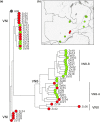Genomic epidemiology of Cryptococcus yeasts identifies adaptation to environmental niches underpinning infection across an African HIV/AIDS cohort
- PMID: 27862555
- PMCID: PMC5412878
- DOI: 10.1111/mec.13891
Genomic epidemiology of Cryptococcus yeasts identifies adaptation to environmental niches underpinning infection across an African HIV/AIDS cohort
Abstract
Emerging infections caused by fungi have become a widely recognized global phenomenon and are causing an increasing burden of disease. Genomic techniques are providing new insights into the structure of fungal populations, revealing hitherto undescribed fine-scale adaptations to environments and hosts that govern their emergence as infections. Cryptococcal meningitis is a neglected tropical disease that is responsible for a large proportion of AIDS-related deaths across Africa; however, the ecological determinants that underlie a patient's risk of infection remain largely unexplored. Here, we use genome sequencing and ecological genomics to decipher the evolutionary ecology of the aetiological agents of cryptococcal meningitis, Cryptococcus neoformans and Cryptococcus gattii, across the central African country of Zambia. We show that the occurrence of these two pathogens is differentially associated with biotic (macroecological) and abiotic (physical) factors across two key African ecoregions, Central Miombo woodlands and Zambezi Mopane woodlands. We show that speciation of Cryptococcus has resulted in adaptation to occupy different ecological niches, with C. neoformans found to occupy Zambezi Mopane woodlands and C. gattii primarily recovered from Central Miombo woodlands. Genome sequencing shows that C. neoformans causes 95% of human infections in this region, of which over three-quarters belonged to the globalized lineage VNI. We show that VNI infections are largely associated with urbanized populations in Zambia. Conversely, the majority of C. neoformans isolates recovered in the environment belong to the genetically diverse African-endemic lineage VNB, and we show hitherto unmapped levels of genomic diversity within this lineage. Our results reveal the complex evolutionary ecology that underpins the reservoirs of infection for this, and likely other, deadly pathogenic fungi.
Keywords: Cryptococcus neoformans; ecological genetics; fungi; microbial ecology; niche modelling.
© 2016 The Authors. Molecular Ecology Published by John Wiley & Sons Ltd.
Figures



Similar articles
-
A New Lineage of Cryptococcus gattii (VGV) Discovered in the Central Zambezian Miombo Woodlands.mBio. 2019 Nov 12;10(6):e02306-19. doi: 10.1128/mBio.02306-19. mBio. 2019. PMID: 31719178 Free PMC article.
-
Cryptococcus tetragattii as a major cause of cryptococcal meningitis among HIV-infected individuals in Harare, Zimbabwe.J Infect. 2016 Jun;72(6):745-752. doi: 10.1016/j.jinf.2016.02.018. Epub 2016 Mar 30. J Infect. 2016. PMID: 27038502
-
Genotypes of Cryptococcus neoformans and Cryptococcus gattii as agents of endemic cryptococcosis in Teresina, Piauí (northeastern Brazil).Mem Inst Oswaldo Cruz. 2011 Sep;106(6):725-30. doi: 10.1590/s0074-02762011000600012. Mem Inst Oswaldo Cruz. 2011. PMID: 22012227
-
The need for environmental surveillance to understand the ecology, epidemiology and impact of Cryptococcus infection in Africa.FEMS Microbiol Ecol. 2021 Jul 7;97(7):fiab093. doi: 10.1093/femsec/fiab093. FEMS Microbiol Ecol. 2021. PMID: 34196370 Free PMC article. Review.
-
Advances in Cryptococcus genomics: insights into the evolution of pathogenesis.Mem Inst Oswaldo Cruz. 2018;113(7):e170473. doi: 10.1590/0074-02760170473. Epub 2018 Feb 19. Mem Inst Oswaldo Cruz. 2018. PMID: 29513784 Free PMC article. Review.
Cited by
-
A Landscape of the Genomic Structure of Cryptococcus neoformans in Colombian Isolates.J Fungi (Basel). 2023 Jan 18;9(2):135. doi: 10.3390/jof9020135. J Fungi (Basel). 2023. PMID: 36836249 Free PMC article.
-
Tackling the emerging threat of antifungal resistance to human health.Nat Rev Microbiol. 2022 Sep;20(9):557-571. doi: 10.1038/s41579-022-00720-1. Epub 2022 Mar 29. Nat Rev Microbiol. 2022. PMID: 35352028 Free PMC article. Review.
-
Microglia are not protective against cryptococcal meningitis.Nat Commun. 2023 Nov 8;14(1):7202. doi: 10.1038/s41467-023-43061-0. Nat Commun. 2023. PMID: 37938547 Free PMC article.
-
Tracing Genetic Exchange and Biogeography of Cryptococcus neoformans var. grubii at the Global Population Level.Genetics. 2017 Sep;207(1):327-346. doi: 10.1534/genetics.117.203836. Epub 2017 Jul 5. Genetics. 2017. PMID: 28679543 Free PMC article.
-
The mycobiome of Australian tree hollows in relation to the Cryptococcus gattii and C. neoformans species complexes.Ecol Evol. 2019 Aug 7;9(17):9684-9700. doi: 10.1002/ece3.5498. eCollection 2019 Sep. Ecol Evol. 2019. PMID: 31534685 Free PMC article.
References
-
- Abarenkov K, Henrik Nilsson R, Larsson K et al (2010) The UNITE database for molecular identification of fungi – recent updates and future perspectives. New Phytologist, 186, 281–285. - PubMed
-
- Anderson MJ (2001) A new method for non‐parametric multivariate analysis of variance. Austral Ecology, 26, 32–46.
-
- Bazzicalupo AL, Bálint M, Schmitt I (2013) Comparison of ITS1 and ITS2 rDNA in 454 sequencing of hyperdiverse fungal communities. Fungal Ecology, 6, 102–109.
-
- Busby J (1991) BIOCLIM ‐ a bioclimate analysis and prediction system. Plant Protection Quarterly, 6, 8–9.
MeSH terms
Substances
Grants and funding
LinkOut - more resources
Full Text Sources
Other Literature Sources
Molecular Biology Databases

